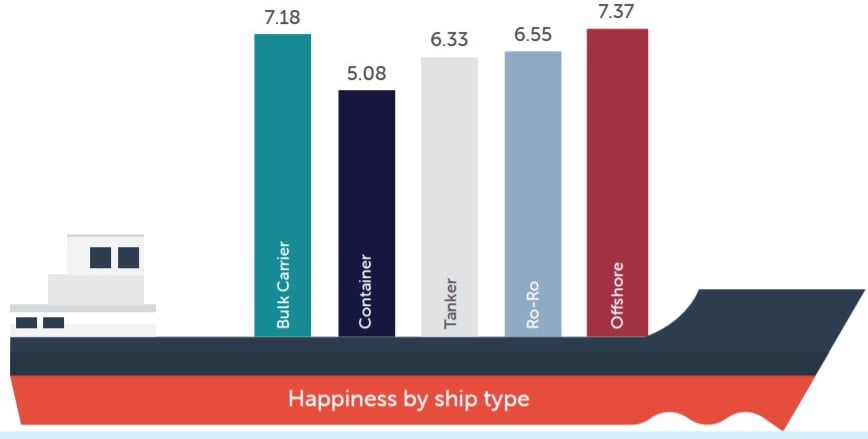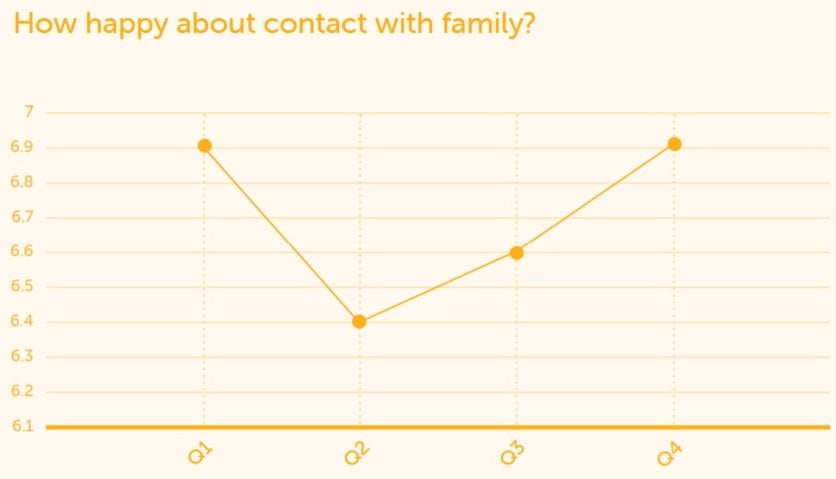The Q4 2021 Seafarers Happiness Index report, published by The Mission to Seafarers, reveals the sustained impact of COVID-19 throughout the year, with the Index’s measure of overall happiness decreasing from 6.59 to 6.41.
The survey highlights that 2021 saw seafarer happiness rise and fall throughout the year, a trend that mirrors the waves of COVID infections.
Where there has been an opening up of economies and international movement, seafarer sentiment has improved, while in times of rising infections and restrictions on movement, happiness levels among seafarers have fallen.
This clear correlation highlights how national decisions impact international seafarers
says the report.
How happy generally when at sea – 6.56 ↓ from 6.8
There is a growing feeling of frustration at sea and uncertainty surrounding trip duration. Lack of shore leave and concerns over getting back to work once they are home, have all combined to create a growing sense of anger. They also make seafaring a less attractive career option, something which was stressed by multiple respondents.
This frustration is seemingly combined with all the other day-to-day issues to create a potentially toxic atmosphere, one which is very likely to have long term implications for recruitment and retention. Regardless of whether seafarers are “happy” with the micro view of their jobs, there is definite anger about the macro employment environment, and that resentment is growing.
Wellbeing crisis
With unpredictable variants and different rates of outbreaks across the world, the ‘yo-yo’ nature of the pandemic is having a serious impact on mental health.
Seafarers raised concerns about the draconian nature of repeated COVID testing, as well as the quality of quarantine provision.
Relationships onboard are also strained and there have been an increasing number of seafarers talking of bullying, harassment, and frictions on their ships.
Growing numbers are reporting of plans for a career change, warning that a shortage of replacement crews and a drain of seafarers away from the industry will be imminent.

Gap in connectivity
The report highlights that progress is being made on the issue of ship-shore connectivity, with seafarers reporting online access has increased.
Seafarers also expressed their gratitude for campaigns to deliver free access to calls or internet access over the holiday period.
However, the survey highlighted a very clear divide between vessels that provided free or affordable access, compared to those that do not.
There is a chasm in the responses, and more and more seafarers are stating that they always check what access they will have before accepting new contracts
the Mission to Seafarers explains.

Recognition for the invisible front-line workers
Seafarers responding to the survey highlighted the lack of recognition as key workers, despite so many initiatives in support of this status.
In addition, concerns were expressed over limited freedom of movement, a shortage of vaccinations, and a perception that the profits of shipping companies are not being fed back into the workforce who keep seaborne trade going.
Some respondents also reported that standards were dropping. It is immensely concerning that practical training for emergencies appears to be falling away.
However, it is perhaps a consequence of the reality of seafarers spending too long at sea. There is apathy creeping in, even about standards and safety. Careful, considered management is needed to make seafarers engage with safety once more.
How happy about access to shore leave – 4.63 ↑ from 4.6
There was very small rise in the data for shore leave – but seemingly more as a reflection that it has gone about as low as it can. Seafarers do not expect to get ashore, and the pandemic has changed the dynamic further.
Vaccinated seafarers feel that they should be able to get ashore and that they should not be treated any
differently to “shore workers being able to leave their place of work, observing the normal mitigations such as social distancing, mask-wearing and hand sanitising”.
How happy about wages/salary – 6.29 ↓ from 6.78
The question of wages saw a fall this quarter, and there was much mention of the perception that shipping’s
financial gains were not being adequately shared amongst seafarers.
Responses included, “Salary is generally good – until you compare it relative to profits. My workload and stress
have increased over the last four years, company profits increased yet my wages remain the same.”
Another stated, “Wages/salary have not been increased at all. We are running the ships day and night 24×7 without any break. We deserve a salary increase.”
How happy about the training you receive – 7.21 ↑ from 7.0
Respondents reported a growing emphasis on training and were very pleased to receive instruction on board or access to courses. However, some felt that the standards are dropping.
Our drills and exercises are pathetic. It seems that no one is interested, and we go through the motions. It is immensely concerning that practical training and practising for emergencies appears to be falling away.
said one concerned seafarer.
How happy about contact with family
In 2021, there has been one seafaring issue that has come to the fore, and that is connectivity, as it seems that progress has been made. Th report heard more seafarers experiencing positives when it comes to getting online and connecting with friends, family and loved ones back home.
Evidence showed that more shipping companies were working to ensure their crews can get online. The impact has been positive and can perhaps be seen as one good thing which has come from the pandemic. More seafarers can now stay connected, and it has become cheaper, easier and a better level of service.
The online “lifeline” for many seafarers on board makes for happier crews. As we heard through the year, seafarers want, need, crave and demand the levels of online access that those ashore are accustomed to. Seafarers want good, affordable and high-quality connectivity. Thankfully, we are seeing improvements. It is just a shame that it has taken such tumultuous events to push improvements.





























































